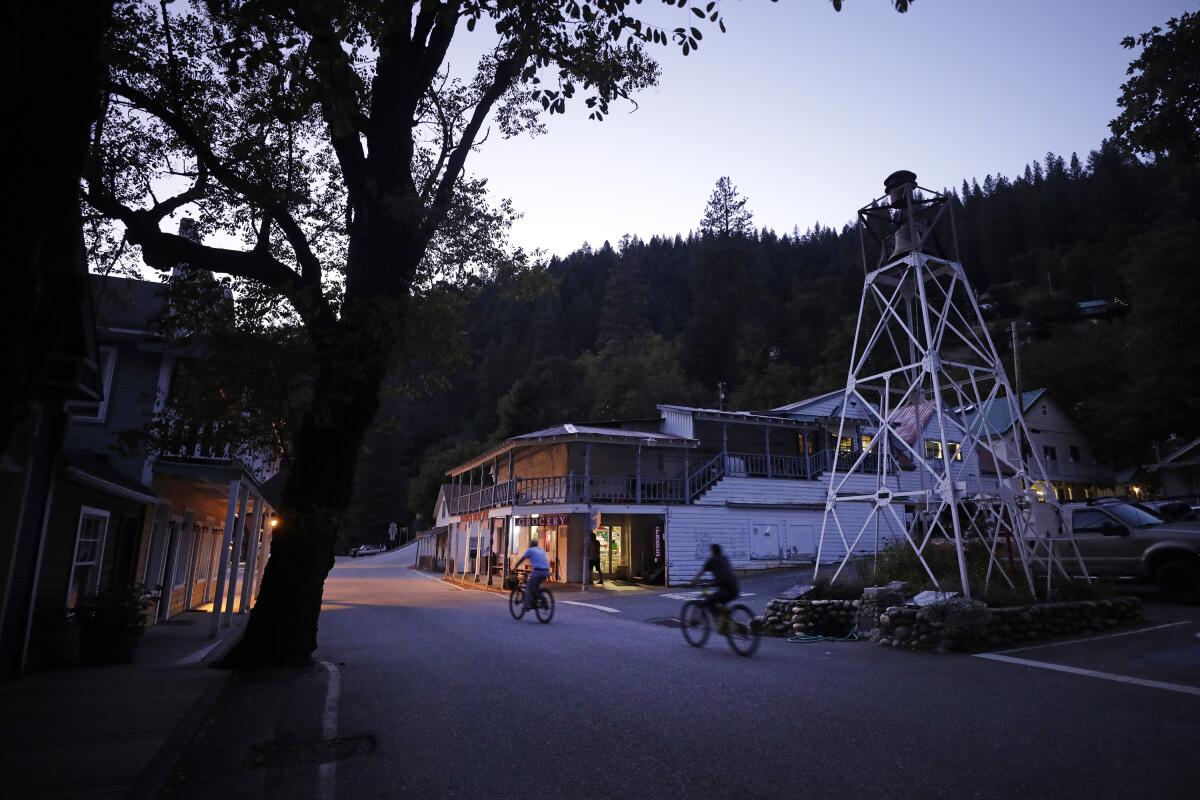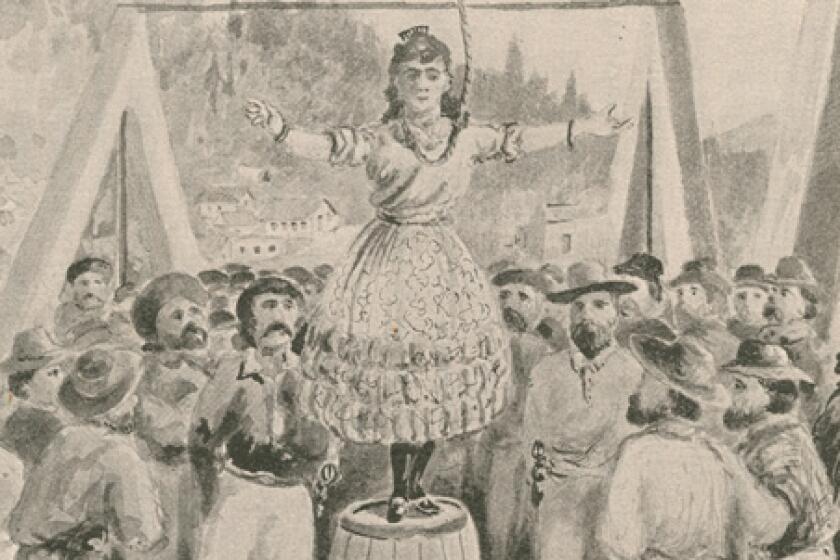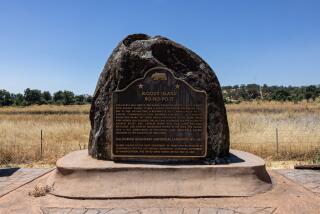A fight over Jim Crow Road divides rural Northern California town

As the story goes, a Native Hawaiian man came as a Gold Rush pioneer to a mountainous swath of Sierra County to strike it rich.
His name was given to a ravine, a stream and a street off scenic Highway 49, three miles east of Downieville, Calif. That’s how Jim Crow Canyon, Jim Crow Creek and Jim Crow Road came to be.
Generations later, people who own property along the less-than-a-mile-long road, including a small mountain resort, say that Jim Crow has got to go.
In April, their pleas sparked a proposal before the Sierra County Board of Supervisors to consider renaming the road.
That has led to counter-complaints from residents of this community about 100 miles northeast of Sacramento, who argue that the effort to expunge the name Jim Crow is an example of “woke cancel culture” run amok.
The debate is unfolding in one of the least ethnically and racially diverse counties in California: About 93% of the 3,000 people who make up Sierra County are white.
“All four property owners have had uncomfortable discussions about the name. Even if it’s a UPS driver delivering something or some public agency that you call and they ask you what your address is and you go ... ‘Jim Crow Road.’ There’s a little twinge when you’re saying it,” said Jim Steinbarth, who has owned property on the road for more than 20 years.
“Nobody wants to make a big issue of this, but especially in today’s political issues and sensitivities I don’t see why there can’t be a compromise.”
Cherry Simi, a Downieville resident who has lived in the area for nearly half a century, questioned the timing of the potential name change.
“It’s very disappointing that that cancel culture movement has affected our small community. I never thought that would happen here,” she said. “There was never any reference I found that compared him to any of the bad Jim Crow image. That was just the guy’s name, and whether or not it was his real name or not, we don’t know. That’s kind of what I’m arguing. Why change it? Just leave it alone.”
The debate over Jim Crow Road is the latest example of political and cultural schisms that can raise temperatures in rural California, away from the spotlight of largely liberal cities such as San Francisco and Los Angeles. Arguments have ensued over a Placerville city logo depicting a noose, which the City Council later voted to remove. Last fall, Squaw Valley Alpine Meadows ski resort near Lake Tahoe announced that it planned to drop the word “squaw” from its name, calling it a derogatory and offensive term.
On Tuesday, the Sierra County Board of Supervisors will hold a public hearing regarding a possible name change.
“A hundred percent of the people that have private property on that road asked for it to be changed,” said Lee Adams, a Sierra County supervisor who brought the issue before the board after hearing from his constituents. “To me, this is just a no-brainer, but I also realize that everybody looks at these things different.”
The words “Jim Crow” have come to stand for the racist laws that for generations kept Black people segregated in the American South. The phrase itself, which predates the Gold Rush, originated in blackface minstrelsy. (Last year, 2,500 miles away in Georgia, Jim Crow Road — named for Glennon “Jim” Crow — was renamed G.C. Crow Road.)
There’s little information in the historical record about a Hawaiian man in the region who somehow came to be called Jim Crow.
“I’ve been to Hawaii many times and I’ve never heard of a Native Hawaiian that was named Jim Crow,” Steinbarth said. “Even if there wasn’t a racist connotation ... I doubt that that was his birth name.”
Fascination with the story of Josefa predates the era of #MeToo and modern-day hostility toward anyone and anything Mexican. But in their own way, the residents of Downieville have long debated the role that Josefa’s gender and ethnicity played in her fate.
Jim Crow, as he’s called, is believed to have been an early pioneer in the region with William Downie, the founder of Downieville.
In his book “Hunting for Gold,” Downie shared a story of the man he called Crow catching “a monster salmon, weighing nearly fourteen pounds.” After boiling the fish in the camp kettle, they found gold at the bottom.
Downie details the two of them, in the fall of 1849, panning for gold and taking out more than a dozen ounces for four days straight. Later, so-called Crow headed out with a handful of men for provisions but never returned to the camp. Downie said he thought he had met his demise.
Months later, after hearing that the Hawaiians had struck it rich, Downie and dozens of other men headed in that direction. To his great surprise, he wrote, he encountered Crow, who he said “held full sway” over his fellow Hawaiian miners.
“The place had already been named Crow City, and the canyon is to this day known as Jim Crow Canyon,” Downie wrote.
Downie wrote that Crow told him “a pack of lies” to explain his not returning to the camp with provisions. He added that many believed the Hawaiians “were only waiting for the white people to vacate, and then they would plunge into the very richest places.”
He wrote that there existed “a singular superstition in regard to Black or colored men” — that they had luck in seeking gold.
“But my experience with Jim Crow was such as to shake my faith in the race, and I made my way back, perfectly satisfied to leave them behind.”
Adams said it’s “hard to fathom that his birth name was Jim Crow.”
“It’s more likely it was a moniker put on him because he was a person of color,” Adams said. “Its insulting nature goes back pre-Gold Rush, so it is very arguable that Downie and his contemporaries picked the name up and said, ‘Oh, you’re Jim Crow.’”
This month, in an email to the clerk to the Board of Supervisors, Tom DeJonghe said guests at the Sierra Shangri-La, a small, rustic resort that he has owned since 1985, “find the road name dismaying (guests sometimes use stronger language against using the Jim Crow name).”
“Guests have not found the Jim Crow name acceptable based on the little-known history of a nickname for a South Pacific miner that worked in the area,” he wrote.
In early April, Adams brought the issue before the board, acknowledging that the discussion wouldn’t be happening if the road was named “Bob Crow or Steve Crow.”
Three of the supervisors spoke out against renaming the road, with one of them questioning why someone would buy property there if they took issue with it. Another said he felt there were “better things to worry about than changing names of roads and changing names of things because it’s a racist thing.”
Supervisor Sharon Dryden said Crow “was a real guy, an immigrant to this country,” adding that she wanted to “respect that legacy that he left.”
“The issues over racial equality, which is why we’re having this discussion right now, have nothing to do with a little road in Sierra County that honors a man that was one of the early settlers,” Dryden said during the public hearing. “I think if I lived on Jim Crow Road I’d be pretty proud of it, probably, because of what his contributions were.”
Ultimately, the board asked for input from the Sierra County Historical Society, which recommended that it be renamed “Crow City Road.” On May 4, the board unanimously voted to hold the public hearing at its June 1 meeting.
Debate has already raged on social media, including about whether Jim Crow was the man’s real name, garnering nearly 100 comments on a post on Simi’s Facebook page. One person questioned whether the Statue of Liberty should be renamed, “because SHE didn’t stand for everybody.” Another said, “Education is better than eradication.”
One person noted an irony amid the roiling debate.
“I’m not sure, but somehow this whole conversation is between older Caucasians aka white folks … no persons involved who have suffered discrimination,” wrote Liz Fisher, a Downieville resident. “Compassion and empathy for other humans is what this is about.”
More to Read
Sign up for Essential California
The most important California stories and recommendations in your inbox every morning.
You may occasionally receive promotional content from the Los Angeles Times.












